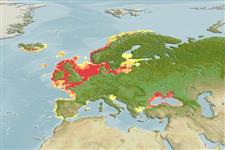Ακτινοπτερύγιοι >
Perciformes (Perch-likes) >
Ammodytidae (Sand lances)
Etymology: Ammodytes: Greek, ammos = sand + Greek, dytes = anyone that likes immersions, diving (Ref. 45335). More on author: Linnaeus.
Περιβάλλον / Κλίμα / Εύρος
Οικολογία
; Θαλασσινό(ά); Υφάλμυρο βενθικό(ς); εύρος βάθους 1 - 96 m (Ref. 57178). Temperate, preferred ?; 72°N - 36°N, 23°W - 42°E
Northeast Atlantic: Murmansk to Spain, including Iceland and the Baltic (Ref. 4674) and the Mediterranean (Ref. 39911). Two distinct but often sympatric spawning groups exist in the area but have not been given subspecies status although spawning groups differ in mean vertebral number (autumn higher than spring), otolith structure, and probably habitats.
Length at first maturity / Μέγεθος / Βάρος / Age
Maturity: Lm ?, range 11 - 15 cm
Max length : 20.0 cm SL αρσενικό/απροσδιόριστο; (Ref. 3397); μεγ. αναφερόμενη ηλικία: 7 έτη (Ref. 729)
Ραχιαίες άκανθες (συνολικά): 0; Μαλακές ραχιαίες ακτίνες (συνολικά): 49-58; Μαλακές εδρικές ακτίνες: 24 - 32; Σπόνδυλοι: 60 - 68. Scales present in the midline anterior to dorsal fin and over the musculature at base of caudal fin. Belly scales in tight chevron. Margins of dorsal and anal fins straight with rays of equal length. Lateral line pores linearly arranged along the un branched canals. Back typically sandy brown.
Territorial; found in inshore waters, especially sandy bays and beaches, including the inter-tidal zone and estuaries; rarely offshore. Alternate between lying buried in the sandy substrate and swimming in schools in the water mass. Adults feed on zooplankton and some large diatoms (Ref. 3397). They hibernate in winter buried in sand at depths of 20-50 cm (Ref. 35388).
Bauchot, M.-L., 1987. Poissons osseux. p. 891-1421. In W. Fischer, M.L. Bauchot and M. Schneider (eds.) Fiches FAO d'identification pour les besoins de la pêche. (rev. 1). Méditerranée et mer Noire. Zone de pêche 37. Vol. II. Commission des Communautés Européennes and FAO, Rome. (Ref. 3397)
IUCN Red List Status (Ref. 115185)
CITES (Ref. 94142)
Not Evaluated
Threat to humans
Harmless
Human uses
αλιεία: πολύ εμπορικό; δόλωμα: usually
Περισσότερες πληροφορίες
ΑναφορέςΥδατοκαλλιέργειεςΠροφίλ υδατοκαλλιέργειαςΣτελέχοιΓενετικήΣυχνότητες αλληλόμορφωνΚληρονομικότηταΑσθένειεςΜεταποίησηMass conversion
ΣυνεργάτεςΦωτογραφίεςStamps, CoinsΉχοιΣιγκουατέραΤαχύτηταΚολυμβητικός ΤύποςΕπιφάνεια βραγχίωνOtolithsΕγκέφαλοιΌραση
Εργαλεία
Special reports
Download XML
Διαδικτυακές πηγές
